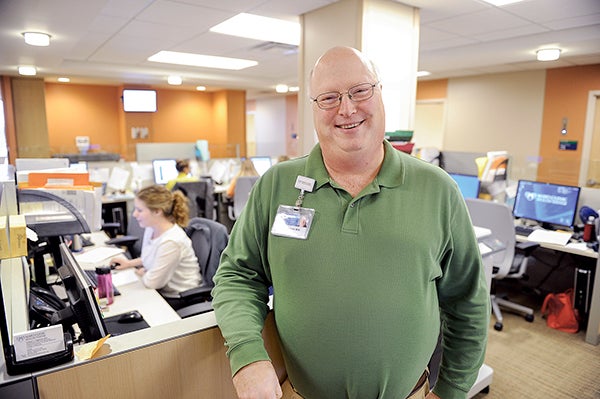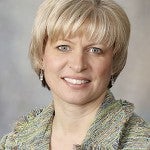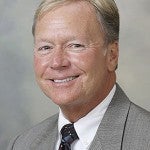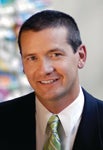Special Report Part I: Hospital trying new approach to patient care with team model
Published 10:31 am Monday, November 4, 2013

Dr. Gregory Angstman is leading a pilot team in a team care approach Mayo Clinic Health System in Austin is trying that will have a team of people helping a patient. Dr. Angstman is standing in a commons area where a majority of the work is done. Eric Johnson/photodesk@austindailyherald.com
A new era in health
Click here for all stories in this series
When Dr. Gregory Angstman started with Mayo in 1990, he worked alone in an office about 40 feet from his nurse.
Today at Mayo Clinic Health System in Austin, Angstman sits at one end of a bustling workspace, side-by-side with Dr. Timothy Rietz and a team: a registered nurse who handles form work, messages, medicine refills and patient education; multiple clinical nurses; nurse practitioners; a medical assistant; a care manager who helps with the most complicated patients; and a doctor of pharmacy.
“None of these other people were here,” Angstman said of the old days.
This team now working in a space Mayo officials call a “neighborhood” is the face of an innovative new approach to caring for patients.
A dramatic change
Administrators at Mayo Clinic Health System agree it’s a transformative time for health care. As the Patient Protection and Affordable Care Act — commonly called Obamacare — has dominated national talk, Mayo Clinic Health System is on the cusp of changes that will affect almost all of its patients.
The old model of one physician caring individually for his or her patients will soon be a thing of the past in Austin and Albert Lea. Instead, the hospital is transitioning into physician-led care teams that administrators like Tammy Kritzer anticipate will be able to treat more patients, improve access to health care and improve health outcomes at a more affordable price — all while keeping patient satisfaction at the same or a better level.
“I think this is the most significant change that the Austin and Albert Lea communities have probably seen in the last 20 to 30 years,” Kritzer, an operations administrator, said. “How we’re going to take care of patients and how we engage partners … will change dramatically.”
The new model isn’t unique to Austin and Albert Lea; Kritzer said it’s happening at all Mayo-owned hospitals and throughout the country.
“This a transformational time, and the pace of change is coming quickly,” Kritzer said. “This is groundbreaking stuff.”
Administrators admit the changes won’t be without anxiety and apprehension for patients or doctors, as patients won’t see their doctors as often.
The change is based on a belief that patients don’t necessarily need to see a doctor at each visit, and that nurses and other professionals can help patients more, which in turn should free up doctors to deal with serious, complicated conditions. This will also allow teams to treat more patients.
Teams will focus on improving patients’ health and preventative care. The teams will help patients manage health concerns like stress and, in time, Waldhoff expects teams will take a proactive role in monitoring patients’ health and making recommendations for healthy lifestyle choices by discussing things like smoking cessation and nutrition.
“Their goal is to prevent you from developing a problem and then having to routinely access your doctor,” Chief Administrative Officer Stephen Waldhoff said.
A matter of quality
The Affordable Care Act in part spurred the change, but issues with the health care industry go deeper. As CEO Dr. Mark Ciota and Waldhoff noted at recent public forums in Austin and Albert Lea, the U.S. is spending more than any other industrialized nation on health care, but ranks among the lowest — 38th by one ranking — in results.
“We’re spending a lot of money and not getting the quality that people deserve,” Ciota said at one forum.
The majority of health care costs are spent on 5 percent of the population — many with chronic illnesses — and almost none is spent on about half of the population because they are seemingly healthy and not receiving treatment, according to Ciota.
Kritzer and Mayo officials have said they owe it to the community to find more effective and affordable means to care for everyone.
“We’re going to bankrupt the country if we keep doing it the way we’re doing it,” Kritzer said.
Waldhoff agreed health leaders must change delivery models to care for more Americans.
“I think health care for all Americans is a right,” Waldhoff said. “Every American has the right to access health care. Unfortunately in our country, health care is predicated upon your economic status, and so we have to recognize one of the things that makes us great as a country is that we’re very supportive of meeting the needs of other individuals, but we have to start here in our own backyard. That’s my opinion.”
While the Affordable Care Act will secure health care for millions of Americans, Waldhoff said millions more continue falling through the cracks.
But Waldhoff sees a silver lining: “It appears there’s sufficient money available within the health care industry. We have to then find a way to distribute those dollars and provide care to a larger population.”
Teamwork
Local health leaders are championing the team approach as vital to the solution. Though Angstman and Rietz’s team is one of only a handful of pilots in Austin and Albert Lea, Mayo officials are calling it the best example of Mayo’s new team approach.
But the team approach is a busier way to work. As Angstman scrolled through medical records on his computer last week, the team chattered behind him: One woman talked on the phone, another read off a list of symptoms and another checked messages. The team collaborates often, asking each other questions and discussing issues.
For Angstman, this was an adjustment.
“There’s more interruptions during the day,” Angstman admitted. “I have more people come to me with questions or problems or issues. That takes a little getting used to.”
The payback is that the team can cooperate and treat more patients. And, the physicians will still oversee the teams.
“We still need physicians to be the so-called captain of the ship,” Ciota said.
Early results are positive. When Angstman worked alone as a traditional doctor, he would see 20 to 25 patients a day and handle 50 to 60 messages. Today, the team, which includes two doctors, handles 75 to 80 patients a day and 300 messages.
“We can handle many more visits and problems in a given day,” Angstman said.
Angstman’s team has time for lunch and finishes the day at 5 or 5:30 p.m. — something rarely done under the old model. One nurse nodded in agreement, admitting she’s happy to work fewer late nights.
“This is much more efficient because you’ve got all of us here,” Angstman said, who added the team reduces the chances of something being delayed or forgotten.
Other measurements have been positive, too. Angstman treats many diabetes patients, and care statistics are showing improvement.
The theory is patients will get better care from the team and fewer will end up in the hospital. However, Angstman said, it’s too early to see if they’ve accomplished that goal.
But one thing’s for sure: Angstman can’t imagine going back to the old care model.
“For me personally, this concept has been revitalizing,” he said. “I enjoy my teammates; I like coming to work with them.”
Angstman said he’s gotten to know his teammates better, and they know the doctors better, too.
“You can be yourself and be human,” he said, noting they learn each others’ behaviors.
“To me, it’s a great way to work,” he added.
The neighborhood layout is vital for team care, according to Angstman, who added it’s important for the team to work side-by-side.
“This model would be difficult without this layout,” he said.
Austin is fortunate, as the clinic designed space for the neighborhoods and team care approach during the medical center’s recent remodel. Not all clinics in the Mayo system are designed to implement the neighborhood workspace, according to Angstman.
The team has one problem: It doesn’t have a team name. Angstman doesn’t want to call it the Angstman-Rietz team, because it leaves out everyone else.
“They don’t call the Vikings the [Adrian] Peterson Team,” he said. “It doesn’t quite feel right.”
‘I still remain involved’
While Angstman now prefers the team approach, Mayo leaders understand it will be an adjustment for patients.
Under the old model, patients typically only saw a nurse and their doctor. Now, they’ll often see a nurse practitioner or even a pharmacist. Angstman and other physicians will still be involved.
“They’re much more likely to see somebody other than me, but I still remain involved,” Angstman said.
Angstman admitted some patients have expressed anxiety over this, but most seem to understand, and patient satisfaction has remained steady or has improved slightly.
Under the new model, patients should have better, more timely access to their care team. If something comes up, Angstman said, patients are much more likely to be seen by a member of the team.
“I think we can better manage their acute care needs,” he said.
To Kritzer, communication will be vital as patients are exposed to the new care method. If patients move ahead blind and see a nurse practitioner when they expect to see their doctor, they’re more likely to be apprehensive. But Kritzer said people are more accepting if the doctor explains the process.
“If we do a poor job of explaining it, people’s expectation is ‘I want the old model,’” she said.
Another concern is familiarity. One woman at Monday’s public meeting was concerned the new model could affect patients’ relationships with doctors.
“We really hope that that personal touch will always stay at the clinic, because that means a lot to us,” the woman said.
When asked if teams will maintain a personal touch, Angstman was pleased to show apples a patient gave him from the man’s apple tree, which the doctor saw as a positive sign.
“I think the patients will feel connected to their doctor,” he said.
Kritzer and Angstman both said the connection could be stronger, as patients will feel connected to the entire team.
“I think the personal connection is stronger,” Angstman said.
Others are still unsure. At Monday’s meeting, resident Kathy Gerlach was apprehensive about the changes, stating she hopes health officials don’t ration care for seniors.
“For us senior citizens, there’s going to be some changes with all the team care,” she said.
Administrators like Waldhoff aren’t surprised. Waldhoff said he understands the hesitancy for seniors to accept this model after spending much of their lives with a doctor they’ve come to know.
“Are you going to want to give up that relationship? Of course not,” Waldhoff said.
But as physicians retire or take jobs in other communities, Waldhoff hopes people will be open to the team approach.
“What we’re asking patients to do is embrace a different model,” Waldhoff said. “You will still have that same physician, but now you have this host of other health care professionals.”
Other residents like Lon Krueger were pleased that Mayo is being proactive about change and is keeping the public informed. He described the team concept as a move in the right direction, and he said he’s curious how it will progress.
“That makes just really wonderful sense,” he said.
Doctor retention
Mayo Clinic Health System in Austin and Albert Lea went through a phase where it had trouble keeping doctors, and many left.
“We went through a period where we lost quite a few of our primary care colleagues,” Ciota said. “And for different reasons.”
But, administrators don’t see this as an institutional problem, and Waldhoff said Mayo is not having trouble hiring new doctors.
Since Jan. 1, Mayo has hired 29 new providers — 14 in primary care — in Austin and Albert Lea.
“Our access has gotten better in the last three months,” Ciota said. “It’s still a long way from where it needs to be.”
Leaders say the teams will be a key way to increase access to care, or the wait time to get an appointment.
Administrators said doctors have left for a variety of reasons: Some have left as spouses seek new jobs, others moved to be closer to family, and many have moved within the Mayo system. Administrators admitted some doctors left due to philosophical differences.
“I think as we move through changes, some people just don’t like to be involved with change,” Ciota said.
However, Kritzer noted Mayo has performed follow-up interviews with doctors who’ve left, and most have said the changes happening at Mayo are happening across the country.
“The old model is: I have one doctor, and they’re my doctor for 25 years,” Kritzer said. “That’s not what the health care of the future is going to look like. Doctors are going to be much more mobile than they ever have been before, and we need to adjust to that.”
‘We owe it to the community’
While the Affordable Care Act has commanded the health care discussions, Kritzer and other administrators aren’t focusing on the politics.
“I don’t feel like that impacts my day-to-day work,” she said. “Our focus every day is to do the best job we can caring for our patients and for our community and for our staff.”
Still, the medical center must comply with the Affordable Care Act, and Kritzer said the law is far from perfect.
Waldhoff agreed political debate shouldn’t be an issue as long as health care leaders have the right priorities.
“The needs of the patient come first,” Waldhoff said.
GOP leaders in Congress have attempted to repeal the act dozens of times. If the law is repealed or changed, Kritzer anticipates the medical center will continue in this direction.
“Even if the Affordable Care Act goes away, we owe it to the newspaper who employs people, we owe it to Hormel Foods who employs people, we owe it to the school district who employs people, we owe it to our community to figure out how to do this,” Kritzer said.





